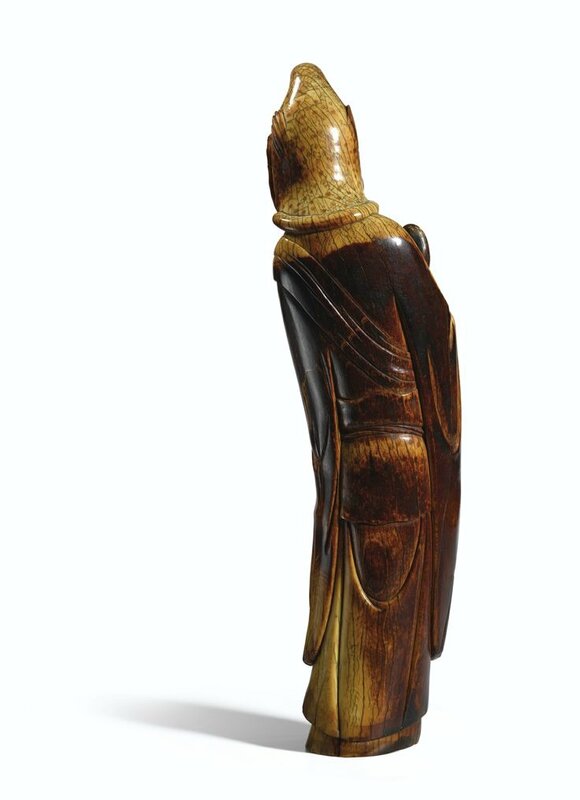A very rare carved ivory figure of a foreigner, Yuan Dynasty
A very rare carved ivory figure of a foreigner, Yuan Dynasty. Photo: Sotheby's.
carved as a standing foreigner with a beard and moustache holding a tray with both hands in front of his chest with a pheasant with finely incised plumage perched atop the tray, the figure's shoulders inclining to his left, his bulging eyes and prominent eyebrows accenting his stern expression, wearing a dotted 'sugarloaf' hat flanked by wing-shaped tips and layers of long robes with the hems ending just above the base, a knot tied loosely in the front and a sash draping diagonally across his body, the patinated ivory of variegated warm amber and brown tones, the base pierced with a circular aperture; 36.2 cm., 14 1/4 in. Estimate 1,800,000 — 2,500,000 HKD
Note: Ivory carvings depicting foreigners are extremely rare and no other related example appears to have been published. The features of the figure continue in the standardised style of the Tang dynasty (618-907), with his bulging eyes, curly beard and tall conical cup. Pottery figures of falconers, merchants and grooms share these features; for example see a sancai groom included in The Special Exhibition of Tang Tri-colour, National Museum of History, Taipei, 1995, cat. no. 51; and another sold in our London rooms, 13th December 1983, lot 88.
According to literary evidence, an ivory workshop that received official patronage was established in the Song dynasty following the availability of African tusks through imports, which marked the beginning of the official ivory carving tradition in China. Examples of figural ivory carvings attributed to the Yuan Dynasty include a pair of standing Buddha figures, published in The Chinese Porcelain Company. A Dealer’s Record 1985-2000, New York, 2000, p. 204; three Buddhist figures seated on animals in the Metropolitan Museum of Art, New York, published in the Museum’s catalogue Chinese Decorative Arts, New York, 1997, p. 39; a standing figure of a Buddha, sold at Christie’s New York, 19th March 2009, lot 601; and a seated Guanyin sold at Christie’s Hong Kong, 30th July 2011, 3329.
Sotheby's. Fine Chinese Ceramics and Works of Art. Hong Kong - www.sothebys.com

/https%3A%2F%2Fprofilepics.canalblog.com%2Fprofilepics%2F1%2F0%2F100183.jpg)
/https%3A%2F%2Fstorage.canalblog.com%2F03%2F02%2F119589%2F96711876_o.jpg)
/https%3A%2F%2Fstorage.canalblog.com%2F11%2F31%2F119589%2F94773502_o.jpg)
/https%3A%2F%2Fstorage.canalblog.com%2F20%2F83%2F119589%2F94772815_o.jpg)
/https%3A%2F%2Fstorage.canalblog.com%2F26%2F72%2F119589%2F75604929_o.jpg)
/https%3A%2F%2Fstorage.canalblog.com%2F59%2F60%2F119589%2F26458628_o.jpg)




/http%3A%2F%2Fstorage.canalblog.com%2F89%2F85%2F119589%2F129503060_o.jpg)
/http%3A%2F%2Fstorage.canalblog.com%2F68%2F96%2F119589%2F128581141_o.jpg)
/http%3A%2F%2Fstorage.canalblog.com%2F08%2F84%2F119589%2F128581002_o.jpg)
/http%3A%2F%2Fstorage.canalblog.com%2F80%2F61%2F119589%2F128580862_o.jpg)